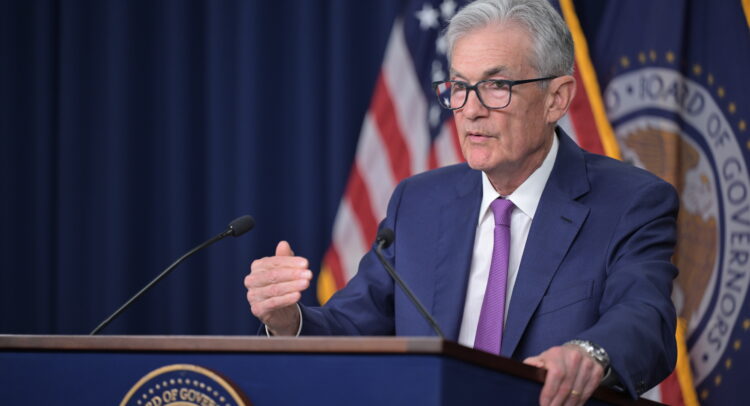Federal Reserve Chair Jerome Powell has been navigating through an economic tightrope that is becoming shaky. If he doesn’t soon pivot, the economy could topple. He must then retain a smooth, steady hand on the controls to gingerly steer the U.S. economy towards a soft landing.
Claim 70% Off TipRanks This Holiday Season
- Unlock hedge-fund level data and powerful investing tools for smarter, sharper decisions
- Stay ahead of the market with the latest news and analysis and maximize your portfolio's potential
Here’s the challenge: In March 2022, the Fed began stepping on the monetary policy brake pedal by lifting overnight bank lending rates (fed funds) from nearly zero to 5.50%, which they are today. Now that the once-hot job market seems to be cooling, economists and investors worry that the Fed may be taking too long to take its foot off the brake pedal.
This worry is based on past experience, as there may only have been one time the Fed has successfully guided the economy down from dizzying heights without crashing it. Controlling the largest economy in the world is like walking a tightrope; it requires insight and steady balance.
In his recent semiannual Monetary Policy Report to Congress, Powell indicated more strongly than ever that the time may be near for a pivot lower. However, since “Fed Speak” is its own language, you may have missed the nuanced message. Powell used the saying- “Elevated inflation is not the only risk we face.” This subtle wording warns of a gradual policy pivot, balancing the dual mandates of controlling inflation and maintaining maximum employment.
The Cooling Economy: A Gentle Slowdown
The U.S. economy has been experiencing a gentle slowdown, with the Consumer Price Index (CPI) data showing a 0.1% decrease from May to June, pushing headline inflation to 3% year-over-year. Core CPI inflation also eased to 3.3% year-over-year, the lowest since April 2021. This cooling trend is unusual, characterized by the unique value of talent in the post-pandemic world, where businesses have invested heavily in retaining their workforce.
Labor Market Normalization: Cooling Employment Conditions
The labor market shows signs of normalization, with the unemployment rate rising to 4.1% in June. Powell acknowledged that recent labor market readings signaled a cooling in employment conditions, noting that the labor market was no longer “a source of broad inflationary pressures for the economy.” This shift has led to a slowdown in payroll and wage growth, both at post-pandemic lows.
The Risks Ahead: Navigating Uncharted Waters
The main risks to the economy lie in the potential for businesses to suddenly get worried and reduce payrolls, leading to a self-fulfilling recession. This is part of why Powell needs a steady hand and cautiously foreshadows the policy moves in advance. The Fed must carefully adjust for these risks as the economy navigates uncharted waters in the post-pandemic labor market.
A Delicate Pivot: The Need for Forward-Looking Adjustments
Considering both mandates and observing two-sided risks to the outlook, it’s time for the Fed to recalibrate monetary policy. Powell is now leading the way in this delicate pivot, adjusting Fed communication to open the door to a potential rate cut in September. His challenge will be to convince his peers on the Federal Open Market Committee (FOMC) that this is the optimal strategy, as several more hawkish officials already appear to be on board with the easing policy.
Key Takeaway
As the Fed navigates the economic tightrope, a subtle shift in policy is underway. Powell’s delicate pivot towards a soft landing is crucial in balancing the dual mandates of controlling inflation and maintaining maximum employment. With the economy cooling and employment conditions normalizing, the Fed must adjust its monetary policy to reflect today’s economic conditions and tomorrow’s likely outlook.
















